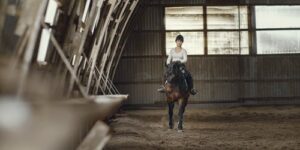Western clothing is integrally related to American history. From cowboy boots to the classic hat, the unmistakable appearance of Western attire today maintains true to its storied heritage. Every pair of denim jeans or designer boots, no matter how promoted and bejeweled, bears testament to a way of life created from the toil and craftsmanship of 19th- and 20th-century cobblers, shoemakers, tailors, and cowboys.
The Original Cowboy Boots
Following the Civil War, many American immigrants migrated west to seek land and a new life. While wearing military-issued Calvary boots, Wellington boots, and other sorts of low-heeled shoes, it became evident that these options would not withstand extended days in the field. In the early 1870s, the first boots built to resist the rigors of the working cowboy were sewn in Coffeyville, Kansas. Cuban heels supported arches, while round toes kept these boots from slipping through the massive stirrups. H.J. “Joe” Justin had established himself as a dominant name on the cowboy boot scene by 1879. Justin’s boots quickly became a popular choice throughout Western America since he was the first to allow mail ordering for his boots. You can see here that these boots acquired popularity throughout the twentieth century as a result of movies, literature, theater, and country music, larger companies arose to satisfy the rising demand. In the 1990s, one of these was Ariat, a well-known and trusted name in Western wear.
Denim Jeans or Waist-High Overalls
Simultaneously with the introduction of cobbled cowboy boots, a tailor in Nevada named Jacob W. Davis submitted to Levi Strauss for a patent for small copper rivets to reinforce the seams and pockets of his waist-high overalls. Because Davis had been producing these rivets successfully for miners, Levi Strauss realized the commercial potential of the rivets and decided to collaborate with Davis. They began with hemp sailcloths for work pants. They later switched to cotton serge de Nimes, more commonly known as denim.
Denim pants were used by blue-collar workers, ranchers, and cowboys by the 1890s. These, too, were adopted into mainstream media venues, resulting in a boom of “dude cowboys.” These men were typical city people who wished to immerse themselves in “genuine” cowboy life. These men would significantly boost the attraction of Western clothes if they wore high-quality boots, denim pants, and hats. In the 1950s, country music musicians who based their careers on the classic cowboy singing style adorned the pants with rhinestones and sequins. Denim pants have become a must-have article of clothing for billions of people around the world. For the best western outfits, look up “western wear men”
The Original Cowboy Hat
Following the attire of Mexican vaqueros (cowboys in Spanish), American and European settlers began to dress like the vaqueros. Everything the vaqueros wore was utilitarian, from their gigantic sombreros to their best cowboy boots and leather chaps to their large hats. American cowboys embraced European-style clothing, including the cap.
Conclusion
While we often identify Western clothes with satin shirts decorated with fringe and rhinestones, actual cowboys wore more utilitarian garments designed for usefulness and longevity rather than show. While the old Western films that we still watch today may have popularized them for the rest of us, these rugged clothing were genuinely designed for a hard life in the elements.
